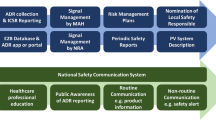Abstract
Background
The prioritisation of drug safety issues for further evaluation or regulatory action is critical to ensure that acceptable timelines and appropriate resource allocation are defined to meet public health and regulatory obligations.
Objective
Our objective was to develop, pilot and implement a novel tool for prioritising pharmacovigilance issues within the Medicines and Healthcare products Regulatory Agency (MHRA).
Methods
An initial system was developed empirically and then piloted over a 10-month period in the pharmacovigilance signal management meeting at the MHRA that discusses potential pharmacovigilance issues, and determines, through consensus, their priority and a timescale for action. The priority assigned by the tool was compared with the priority decided by collective judgement at the meeting. Once an acceptable level of concordance between the tool and the meeting had been achieved, the finalised tool was implemented into routine use at the MHRA, with an evaluation of its performance conducted after the first year.
Results
The Regulatory Pharmacovigilance Prioritisation System (RPPS) tool prioritises pharmacovigilance issues according to the following four broad categories, each with four inputs: strength of evidence, public health implications, agency regulatory obligations and public perceptions. A weighted scoring system links the inputs to a pre-defined number of points where if a threshold is reached then the points are awarded. The overall priority is determined by the sum of all points obtained from each of the inputs. The pilot study included a total of 73 pharmacovigilance issues during the 10-month study period, with an overall exact agreement between the RPPS priority and the collective judgement of the meeting of 60.3 %. Where exact agreement was not obtained, the RPPS generally prioritised the issues slightly higher than the meeting. Over the first year following implementation, the RPPS achieved an overall exact agreement of 82.2 %.
Conclusion
Following the pilot study and implementation at the UK MHRA, the RPPS has provided a systematic approach to drug safety issue prioritisation that should help to reduce the subjectivity of reliance on individual judgement.




Similar content being viewed by others
References
CIOMS. Practical aspects of signal detection in pharmacovigilance: report of CIOMS Working Group VIII. Council for International Organizations of Medical Sciences; 2010.
Ekins-Daukes S, Kauser S, Wise L. Signal detection in the UK: the use of quantitative methods at the MHRA [Abstract]. Drug Saf. 2007;30(10):963.
Evans SJW, Waller PC, Davis S. Use of proportional reporting ratios (PRRs) for signal generation from spontaneous adverse drug reaction reports. Pharmacoepidemiol Drug Saf. 2001;10:483–6.
Bate A, Linquist M, Edwards IR, et al. A Bayesian neural network method for adverse drug reaction signal generation. Eur J Clin Pharmacol. 1998;54:315–21.
van Puijenbroek EP, Diemont WL, van Grootheest K. Application of quantitative signal detection in the Dutch spontaneous reporting system for adverse drug reactions. Drug Saf. 2003;26(5):293–301.
Hauben M. Signal detection in the pharmaceutical industry: integrating clinical and computational approaches. Drug Saf. 2007;30(7):627–30.
Waller P, Heeley E, Moseley J. Impact analysis of signals detected from spontaneous adverse drug reaction reporting data. Drug Saf. 2005;28(10):843–50.
Heeley E, Waller P, Moseley J. Testing and implementing signal impact analysis in a regulatory setting. Drug Saf. 2005;28(10):901–6.
DuMouchel W. Bayesian data mining in large frequency tables, with an application to the FDA spontaneous reporting system. Am Stat. 1999;53:177–90.
Landis JR, Koch GG. The measurement of observer agreement for categorical data. Biometrics. 1977;33:159–74.
Acknowledgments
Funding was provided internally by the MHRA. Patrick Waller was contracted as a consultant to the MHRA during the period of this study. Suzie Seabroke, Lesley Wise and Patrick Waller have no conflicts of interest that are directly relevant to the content of this study.
Author information
Authors and Affiliations
Corresponding author
Rights and permissions
About this article
Cite this article
Seabroke, S., Wise, L. & Waller, P. Development of a Novel Regulatory Pharmacovigilance Prioritisation System: An Evaluation of Its Performance at the UK Medicines and Healthcare products Regulatory Agency. Drug Saf 36, 1025–1032 (2013). https://doi.org/10.1007/s40264-013-0081-3
Published:
Issue Date:
DOI: https://doi.org/10.1007/s40264-013-0081-3




